











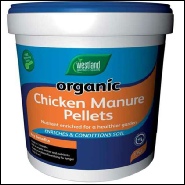
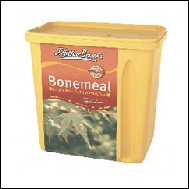
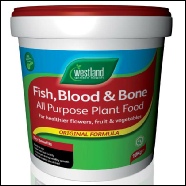
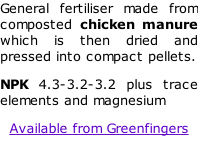
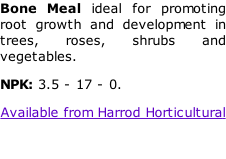
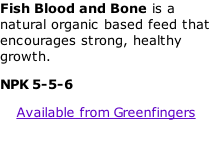
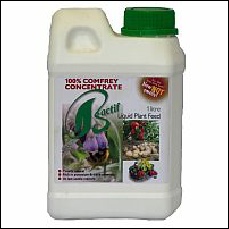
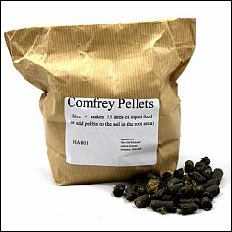
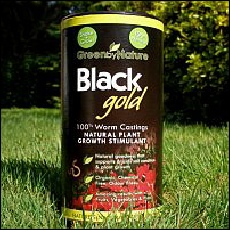


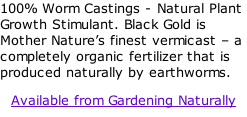
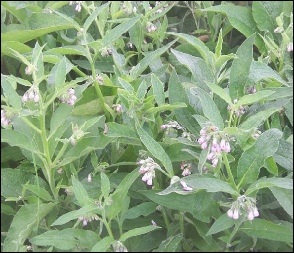

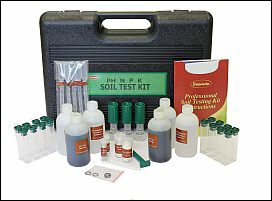
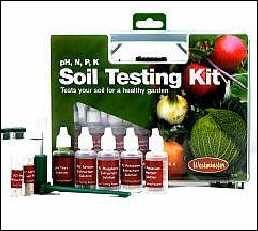











If your soil has just been cleared and hasn’t been used for growing before then you will probably not need to use a fertiliser. New ground often produces fantastic crops. Over the years plants use up the natural nutrients in the soil and so the fertility needs supplementing with a fertiliser of some sort.
Fertilisers contain three main plant nutrients, nitrogen (N) which is needed for healthy leaf growth, Phosphorus (P) which is needed by plants to produce healthy roots and shoots and Potassium (K) which is of general benefit to plants but is particularly necessary for plants to produce fruit and flower. Fertilisers also contain very small amounts of trace elements such as iron and manganese.
The proportions of N, P and K should be quoted on all fertiliser packs as N:P:K so 10:12:24 indicates that the fertiliser is high in potassium and would therefore be good to use on fruiting or flowering plants.
When using fertilisers it is important to follow the instructions on the labels. Just in case the label becomes unreadable you may find it useful to male a note of the instructions to keep somewhere safe.
Organic fertilisers tend to be slower acting and have organic origins. They include seaweed, hoof & horn, dried blood, fish blood & bone, bone meal, poultry manure pellets and liquid comfrey or nettle feeds.
Fertilisers can be bought that include a mixture of N, P and K these are referred to as compound fertilisers. Straight fertilisers are based on one major nutrient and are usually inorganic. Control release fertilisers also are usually inorganic; these release nutrients gradually into the soil over a period controlled by a porous coating. Slow release fertilisers are usually organic and gradually broken down by soil organisms.
Different fertilisers require different methods of application and you should always follow the instructions on labels.
They may be sprinkled on the soil surface usually in spring. This is called top dressing. Care should be taken not to get fertiliser on leaves as they could burn. Too much fertiliser applied this way can also damage roots so carefully read the application guidance.
Fertiliser can be incorporated in soil or compost before planting; this is called base dressing.
Liquid or soluble powered fertilisers can be watered onto plant roots. Again care should be taken not to splash leaves. These fertilisers tend to be used for container or greenhouse grown plants.
Some fertilisers can be applied by direct spraying or watering onto leaves. This is called foliar feeding and should not be carried out during sunny periods as the leaves may be scorched. Spray applied to young leaves and the undersides of leaves is particularly effective.
If you grow comfrey you can make your own comfrey tea.
Just use a container large enough to hold the amount of comfrey and cover it with water. Leave it for about 3 weeks and then strain off the liquid. Dilute it 10 parts water to 1 of comfrey juice and use a a general plant feed. Beware it des smell foul!
If you would like to grow comfrey then plants can be bought from Victoriana click here and for seeds click here They supply Russian comfrey which is slightly different to the one in the picture on the right.
Soil also needs to have a good structure or texture, it shouldn’t be too cloggy or it can become waterlogged but neither should it be too sandy as water will quickly drain through leaving the top layer arid. The aim is for a crumbly soil containing air pockets. Soil conditioners are used to improve the soil structure. Conditioners include homemade compost, spent grow bags, mushroom compost and manure. (Read this before acquiring manure).Some soil conditions such as mushroom compost can alter the PH of the soil
You may also like to learn about our experiences with green manures click here for more.
The PH of soil is also important. The PH indicates whether the soil is alkaline or acidic.
A PH of around 7.0 indicates that the soil is neutral i.e. neither alkaline nor acidic.
A PH level of 6.5 is considered the best level for most plants. Soil testing kits to check the PH level are available.
If the soil PH is too low garden lime can be added. It is important that garden lime and not builders’ lime is used. There are also applications containing sulphur and iron sulphate available to lower the PH if the soil is too alkaline.
Some plants grow better in soil that is acidic or alkaline so you should read up on your plants requirements before purchasing.
Kits are available to enable you to check the PH level of soil but bear in mind that this may vary in different parts of your plot or garden so you need to test in various location.
Some tests use a probe but from what I have been told by other gardeners these may not be as reliable as those which use a liquid formula.





































